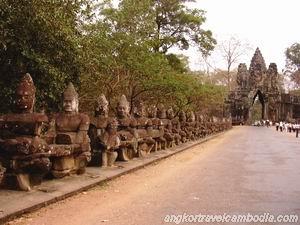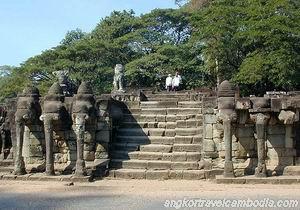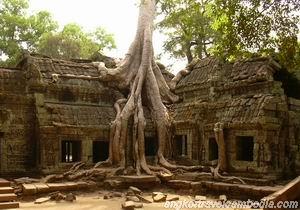| |
|

The Angkor
Wat Temple, the mysterious Hindu Temple built by King Suryavarman
II at the height of the Khmer Empire in the 12th century is the
world's largest temple complex. Consists of many sandstone temples,
chapels, causeways, terraces and reservoirs, it is believed that
the gods assisted the architect whose identity remains a mystery
until today. The walls of the temple are covered with thousands
of carving depicting scenes of confrontations between the gods
and the demons of classical Hindu mythology. Yet on some are genial-dancing
ladies known as "Apsara" and on others depicting royal
processions with the king and other royalties riding on elephants.
Whatever it is, the carvings are clearly masterpieces in the true
sense. There is much about Angkor Wat that is unique among the
temples of Angkor. The most significant point is its westward
orientation. West is symbolically the direction of death, which
once led many scholars to conclude that Angkor Wat was primary
a tomb. This was supported by the fact that the magnificent bas-reliefs
of Angkor Wat were designed to be viewed in an anticlockwise direction,
a practice which has antecedents in Hindu funerary rites. Vishnu,
however, is often associated with the west , and it is commonly
accepted nowadays that Angkor Wat was probably both a temple and
a mausoleum for Suryavarman II.

The fortified
city of Angkor Thom, some 10sq km in extent, was built by Angkor's
greatest King, Jayavarman VII (ruled 1181-1201). Centered on Baphuon,
Angkor Thom is enclosed by a square wall 8m high and 12km in length
and encircled by moat 100m wide, said to have been inhabited by
fierce crocodiles. The city has five monumental gates, one each
in the north, west and south walls and two in the east wall. In
front of each gate stand giant statues of 54 gods (to the left
of the causeway) and 54 demons (to the right of the causeway),
a motif taken from the story of the Churning of the Ocean of Milk
illustrated in the famous bas-relief at Angkor Wat. In the center
of the walled enclosure are the city's most important monuments,
including the Bayon, the Baphuon, the Royal Enclosure, Phimeanakas
and the Terrace of Elephants.

The Bayon
takes an easy second place after Angkor Wat. The smile of the
four-faced Bayon has become a world-recognized symbol of Cambodia.
The towering faces, reaching up to four meters in height, adorn
the Bayon Temple at the exact center of Angkor Thom in Siem Reap.
As many as 216 faces on the 54 remaining towers, each represented
one province of Khmer empire in the ancient time. The Bayon is
now known to have been built by Jayavarman VII . There is still
much mystery associated with the Bayon - its exact function and
symbolism - and this seems only appropriate for a monument whose
signature is an enigmatically smiling face.

The 350m-long
Terrace of Elephants was used as a giant reviewing stand for public
ceremonies as well as a base for the king's grand audience hall.
The Terrace of Elephants has five extending towards the Center
Square, three in the center and one at each end. The middle section
of the retaining wall is decorated with life-size garudas and
lions; towards either end are the two parts of the famous parade
of elephants.

The Baphuon,
a pyramidal representation of mythical Mt Meru, is 200m north
- west of the Bayon. It was constructed by Udayadityavarman II
(reigned 1049-65) and marked the center of the city that existed
before the construction of Angkor Thom. The Baphuon is in pretty
poor shape and at the time of writing, it was being restored by
a French team, with much of the temple marked off-limits. It is
approached by a 200m elevated walkway made of sandstone. The central
structure is 43m high, but unfortunately its submit has collapsed
(it may be restored). On the west side of the temple, the remaining
wall of the second level was fashioned-apparently in the 15th
century into a reclining Buddha 40m in length.

Banteay Srey
was built in the late 10th century and is a Hindu temple dedicated
to Shiva. The temple is square with entrances at the east and
west. Of chief inter-east are the three central towers, which
are decorated with male and female divinities and beautiful filigree
relief work. Banteay Srey is 21km north-east of the Bayon and
8km west of Phnom Kulen. You can combine a visit here with a trip
to the sacred mountain of Phnom Kulen.

The temple
of Ta Prohm rates with Angkor Wat and the Bayon as one of the
most popular attractions of Angkor . Ta Prohm is a unique other-world
experience. The temple is cloaked in dappled shadow, its crumbling
towers and walls locked in the slow muscular embrace of vast root
systems. If Angkor Wat , the Bayon and other temples are testimony
to the genius of the Angkor-period Khmers, Ta Prohm reminds us
equally of the awesome fecundity and power of the jungle. Built
in approximately 1186, Ta Prohm was a Buddhist temple dedicated
to the mother of jayavarman VII. Ta Prohm is a temple of towers,
close courtyards and narrow corridors. Many of the corridors are
impassable, clogged with jumbled piles of delicately carved stone
blocks dislodged by the roots of long-decayed trees.
Bas-reliefs on bulging walls are carpeted by lichen, moss and
creeping plants, and shrubs sprout from the roofs of monumental
porches. Trees, hundreds of years old - some supported by flying
buttresses - tower overhead, their leaves filtering the sunlight
and casting a greenish pall over the whole scene.

The temple
of Preah Khan (Sacred Sword) is a good counterpoint to Ta Prohm,
though it gets far fewer visitors. Preah Khan was built by Jayavarman
VII (it may have served as his temporary residence while Angkor
Thom was being built), and like Ta Prohm it is a place of towered
enclosures and shoulder-hugging corridors. The central sanctuary
of the temple was dedicated in 1191, Preah Khan's role as a center
for worship and learning. Preah Khan cover a very large area,
but the temple itself is within a rectangular enclosing wall of
around 700m by 800m. Four processional walkways approach the gates
of the temple, and these are bordered by gods carrying a serpent,
as in the approach to Angkor Thom. From the central sanctuary,
four long vaulted galleries extend in the cardinal directions.
Many of the interior walls of Preah Khan were once coated with
plaster held in place by holes in the stone.
Sras Srang
(Pool of Ablution) is a basin of earlier construction, measuring
800m by 400m. A tiny island in the middle once bore a wooden temple,
of which only the stone base remains. There is a mass grave of
hundreds of victims of
the Khmer Rouge further north of Sras Srang on the other side
of the road . It is marked by a wooden memorial.

The late 12th
century Buddhist temple of Preah Neak Pean (Intertwined Naga),
which was built by Jayavarman VII, consists of a square pool with
four smaller square pools arranged on each
axis. In the center of the large central pool is a circular "island"
encircled by the two Naga whose intertwined tails give the temple
its name. Water once flowed from the central pool into the four
peripheral pools via ornamental spouts, which can still be seen
in the pavilions at each axis of the pool. The spout are in the
form of an elephant's head, a horse's head, a lion's head and
a human's head. The pool was used for ritual purification rites
and the complex was originally in the center of a huge 3km by
900m lake, now dried up and overgrown. 
|
|